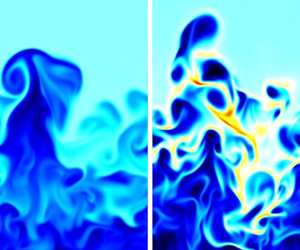Article contents
Inertial effects in dusty Rayleigh–Taylor turbulence
Published online by Cambridge University Press: 07 September 2021
Abstract

We investigate the dynamics of a dilute suspension of small, heavy particles superposed on a reservoir of still, pure fluid. The study is performed by means of numerical simulations of the Saffman model for a dilute particle suspension (Saffman, J. Fluid Mech., vol. 13, issue 1, 1962, pp. 120–128). In the presence of gravity forces, the interface between the two phases is unstable and evolves in a turbulent mixing layer which broadens in time. In the case of negligible particle inertia, the particle-laden phase behaves as a denser fluid, and the dynamics of the system recovers to that of the incompressible Rayleigh–Taylor set-up. Conversely, particles with large inertia affect the evolution of turbulent flow, delaying the development of turbulent mixing and breaking the up–down symmetry within the mixing layer. The inertial dynamics also leads to particle clustering, characterised by regions with higher particle density than the initial uniform density, and by the increase of the local Atwood number.
JFM classification
- Type
- JFM Papers
- Information
- Copyright
- © The Author(s), 2021. Published by Cambridge University Press
References
REFERENCES
- 5
- Cited by





